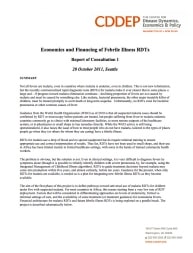November 26, 2013

The Question
The aim of the first phase of this project is to define pathways toward universal use of malaria RDTs for children under five with suspected malaria. For most countries in Africa, this means starting from a very low rate of RDT deployment. Factors that will be considered in differentiating approaches are levels of endemicity, formal vs. informal settings of care, and the availability of some kind of treatment guidance for non-malarial fevers. Financial architecture for malaria RDTs and future febrile illness RDTs is being explored on a parallel track. The project is described schematically below.
What we found
On October 20, 2011, the first consultation brought together major stakeholders and experts on febrile illness and RDTs. The consultation included evaluation of malaria RDTs, which already exist, and RDTs being developed for other conditions. It also provided a starting point for broadening the discussion–from diagnosing and treating children with suspected malaria or suspected pneumonia to viewing febrile illness as category that includes these and other causes. The work on cost-effectiveness will begin with malaria RDT use and expand to febrile illness RDTs.
Why it matters
Not all fevers are malaria, even in countries where malaria is endemic, even in children. This is not new information, but the recently commercialized rapid diagnostic tests (RDTs) for malaria make it clearer that in some places where the progress toward malaria elimination is declining rapidly, a large proportion of fevers are not caused by malaria. Besides malaria, bacterial pneumonia is also another major (treatable) disease killing children and thus, it must be treated promptly to avert death. Unfortunately, no RDTs exist for bacterial pneumonia and other common causes of fever.
As per the guidelines laid down by the World Health Organization (WHO) as of 2010, all suspected malaria cases should be confirmed by RDT or microscopy before patients are treated. However, people suffering from fever in malaria endemic countries commonly go to clinics with minimal laboratory facilities, remote outposts of the healthcare system, or pharmacies and small shops to buy remedies directly. While the WHO’s advice is still being operationalized, it also raises the issue of how to treat people who do not have malaria, tailoring it to the types of places people go when they (or others for whom they are caring) have a febrile illness. Although RDTs for malaria don’t need any special equipment except a drop of blood, healthcare providers must be given some kind of training to ensure that these tests are correctly used and results are accurately interpreted. Till now, RDTs have not been used in small shops, and their use in Africa has been limited to formal healthcare settings. Moreover, a small number of these tests have been given to a few trained community health workers.
The problem is obvious, but the solution is not. Even in clinical settings, it is very difficult to diagnose fevers by symptoms alone (though it is possible to identify children with severe pneumonia by using the “Integrated Management of Childhood Illness” algorithm). RDTs to guide treatment decisions beyond malaria may be developed within five years, and certainly, before ten years. Guidance for the present use of RDTs (for diagnosing malaria) is needed along with a plan for integrating new febrile illness RDTs as they become available in the coming years.

